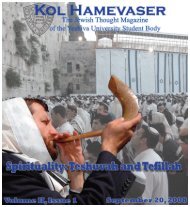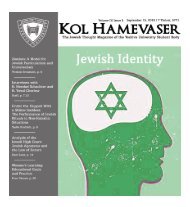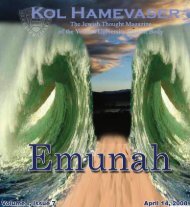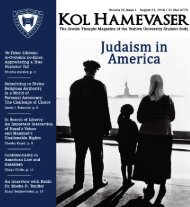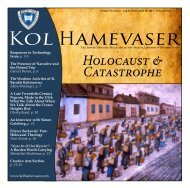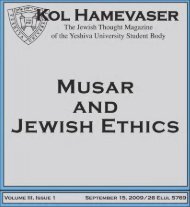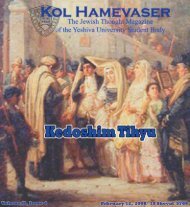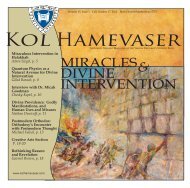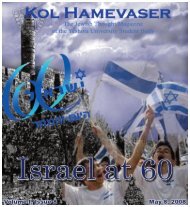You also want an ePaper? Increase the reach of your titles
YUMPU automatically turns print PDFs into web optimized ePapers that Google loves.
<strong>Halakhah</strong> <strong>and</strong> <strong>Minhag</strong><br />
Creativity, Not Formalism:<br />
Towards a Survey of Rav Yoel Bin-Nun’s Halakhic Methodology<br />
BY: Shlomo Zuckier<br />
Rav Yoel Bin-Nun is known as one of<br />
the most creative minds of the past<br />
generation in the Orthodox world. His<br />
most acknowledged accomplishments are in<br />
the world of Tanakh, where he has been one of<br />
the leading revivers of Orthodox literary<br />
Tanakh scholarship in Israel over the last 30<br />
years, presiding over the Tanakh revolution. i<br />
He has lectured extensively in Talmud, serving<br />
as a Rosh Yeshivah at Yeshivat ha-Kibbuts ha-<br />
Dati for several years, until his retirement in<br />
2006. He has spent significant time <strong>and</strong> energy<br />
in the realm of Mahashavah (philosophy) as<br />
well, recently finishing his dissertation on R.<br />
Abraham Isaac ha-Kohen Kook. ii<br />
This article, however, will ignore all of<br />
those accomplishments <strong>and</strong> focus on the halakhic<br />
output of this ish eshkolot (Renaissance<br />
man). Over the last couple of years, R. Yoel<br />
has published a collection of halakhic works<br />
(Me-Hevyon Oz iii ). A different book he recently<br />
published also contains some halakhic material,<br />
iv <strong>and</strong> he has also lectured on his halakhic<br />
opinions, some of which are well known.<br />
While this article will present a preliminary<br />
thesis of his halakhic methodology <strong>and</strong> principles,<br />
it will not serve as a true critique of the<br />
validity of his positions, though it will note<br />
cases where he diverges from st<strong>and</strong>ard positions.<br />
I will note at the outset that this article’s<br />
purpose is to attempt to outline R. Yoel’s approach<br />
to pesak <strong>Halakhah</strong> based on principles<br />
that are reflected in his halakhic positions. Due<br />
to limitations of space <strong>and</strong> the author’s limited<br />
assertiveness, it will not attempt to locate<br />
where this position falls among the gamut of<br />
approaches to <strong>Halakhah</strong> (though follow-up articles<br />
on the matter are welcome).<br />
R. Yoel is a creative <strong>and</strong> maverick thinker,<br />
in all areas of his Jewish oeuvre, including his<br />
halakhic pesakim. One notices this approach<br />
immediately upon meeting R. Yoel, as he usually<br />
is found wearing his tsitsit on his suit<br />
jacket, an extremely rare halakhic practice. v<br />
The sources that he utilizes as the bases for his<br />
pesak are the traditional halakhic works of the<br />
Shulhan Arukh <strong>and</strong> its commentaries, as they<br />
follow the track laid out for them by the<br />
Gemara <strong>and</strong> Rishonim. However, there is a<br />
certain distinctive nature in the methodology<br />
of how he reaches his decisions, which this article<br />
will attempt to spell out.<br />
An important preliminary note to make is<br />
that R. Yoel’s positions are neither consistently<br />
meikel (lenient) nor mahamir (stringent), but<br />
are certainly often distinct from the norm. If<br />
he feels that a certain position is right, he will<br />
argue powerfully for it, regardless of how it<br />
squares with mainstream contemporary practice.<br />
Probably the most important <strong>and</strong> basic<br />
principle of R. Yoel’s halakhic methodology is<br />
the idea of returning to the original sources <strong>and</strong><br />
principles <strong>and</strong> ensuring that they are being followed<br />
in current-day reality, vi as opposed to<br />
certain other approaches that favor traditional<br />
interpretation <strong>and</strong> development. As explained<br />
above, this can make his opinion fall out on the<br />
meikel or the mahamir side of things, <strong>and</strong><br />
sometimes on both sides within the same issue.<br />
A particularly good representative case of this<br />
ideology is R. Yoel’s opinion concerning the<br />
prohibition (for some) against eating kitniyot<br />
(legumes) on Pesah. The original prohibition<br />
was on legumes, such as beans, <strong>and</strong> on rice,<br />
with the idea that they resembled hamets <strong>and</strong><br />
might present problems if hamets <strong>and</strong> kitniyot<br />
were confused. R. Yoel’s approach to this law,<br />
which he maintains for the general public as<br />
well, vii diverges in two major practical senses<br />
from the st<strong>and</strong>ard pesak <strong>Halakhah</strong>. R. Yoel’s<br />
first contravention of mainstream current practice<br />
is his claim that processed legumes (e.g.<br />
corn oil) are permissible. He argues this based<br />
on the fact that the original reason for the law<br />
does not apply since such processed foods cannot<br />
possibly be mistaken for hamets, <strong>and</strong> also<br />
that the formal Rabbinic institution against<br />
such foods was only said about them in their<br />
solid forms, not their processed versions. viii<br />
This is obviously a significant kulla (leniency),<br />
<strong>and</strong> it makes R. Yoel’s following point more<br />
surprising. His other argument is that, since<br />
the original reason of the takkanah (decree) is<br />
to prevent people from confusing hamets with<br />
non-hamets, one should refrain from consuming<br />
cakes <strong>and</strong> the like which closely resemble<br />
hamets, even if they do not contain rice or<br />
legumes. (These foods have a major market,<br />
both in Israel <strong>and</strong> in huts la-arets.) In other<br />
words, R. Yoel ignores the formal categories<br />
usually made of kitniyot <strong>and</strong> non-kitniyot<br />
foods, focusing instead on the practical categories<br />
used when the law was instituted in the<br />
first place: food that can be confused with<br />
hamets <strong>and</strong> food that cannot be confused with<br />
hamets – <strong>and</strong> applying it to today’s reality.<br />
Thus, the original intention behind the law is<br />
preferred to its practical application. ix<br />
This reliance on the original reason for the<br />
law <strong>and</strong> not the technical details that developed<br />
over time, especially when they do not fit the<br />
original purpose, is part of a broader idea in R.<br />
Yoel’s halakhic philosophy that values making<br />
<strong>Halakhah</strong> applicable <strong>and</strong> realistic to our generation.<br />
One particularly striking application<br />
of this philosophy is how he views the law of<br />
sof zeman keri’at Shema (the latest time to recite<br />
the Shema). The Mishnah says that those<br />
who are obligated in reading Shema daily can<br />
do so until the third hour of the day because<br />
that is when princes, the latest risers, awake. x<br />
R. Yoel claims (it is unclear if he is claiming<br />
what the halakhah should be or what it is <strong>and</strong><br />
whether he advises this in practice) that in our<br />
day, when it is st<strong>and</strong>ard for people to awake<br />
even later, the time period for saying Shema<br />
should be later. He sees the law as not m<strong>and</strong>ating<br />
specifically the third hour, but as representing<br />
the realistic time when people tend to<br />
awake.<br />
Another significant example of this approach<br />
appears in R. Yoel’s suggested valuation<br />
of a ketubbah agreement. In an article he<br />
wrote on this topic, xi he presents several different<br />
monetary sums at which the ketubbah is<br />
generally valued.. They are based on the value<br />
of silver in our time <strong>and</strong> compared to the<br />
Gemara’s value of ketubbah (200 zuz plus tosefet<br />
ketubbah [additional <strong>and</strong> technically optional<br />
though universally given ketubbah<br />
money]), <strong>and</strong> are mostly in the range of 2,500<br />
shekel. He rejects these positions (favoring the<br />
last, though) on the basis of several conceptual<br />
errors he claims were made in calculating these<br />
values. His primary argument is that these<br />
sums are not sufficient to accomplish the purpose<br />
of ketubbah, which is to provide financial<br />
stability for the kallah (bride) in the event of<br />
divorce or her husb<strong>and</strong>’s death, <strong>and</strong> he therefore<br />
proposes a vastly different model. R. Yoel<br />
connects the 200 zuz necessary for a ketubbah<br />
to the Mishnah in Pe’ah (8:8) that defines 200<br />
zuz as the average yearly income, <strong>and</strong> he calculates,<br />
including tosefet <strong>and</strong> nedunya (stan-<br />
Volume III, Issue 7 www.kolhamevaser.com<br />
dard dowry), that a st<strong>and</strong>ard contemporary ketubbah<br />
should be about 50,000 shekel today.<br />
In other words, he ignores the formalistic<br />
method of calculating <strong>and</strong> instead relies on the<br />
principle of supplying the kallah with a livelihood<br />
in the event of divorce or her husb<strong>and</strong>’s<br />
death. Interestingly, in a response to this piece,<br />
R. Gideon Binyamin argues:<br />
“It is important to remember in general<br />
that even though this or that takkanah of<br />
Hazal has a specific reason, once Hazal<br />
instituted <strong>and</strong> defined (higdiru) it, we do<br />
not any longer consider the reason of the<br />
institution, but we relate to it as it was defined<br />
by Hazal.” xii<br />
This comment fairly represents the consensus<br />
view of most posekim, but it is on this<br />
very principle that R. Yoel argues. He does not<br />
see the halakhic system as based on Hazalm<strong>and</strong>ated<br />
details, but rather on the principles<br />
that motivated them, <strong>and</strong> thus he feels comfortable<br />
not following the st<strong>and</strong>ard practice <strong>and</strong><br />
going instead in directions of his own.<br />
In keeping with his view that the halakhic<br />
system has to be relevant to any time, R. Yoel<br />
not only has different halakhic positions on<br />
classic halakhic issues (such as the ones discussed<br />
above), but at times he also creates<br />
novel halakhic categories.<br />
One example of R. Yoel’s preference for<br />
reality-based <strong>and</strong> non-formalistic underst<strong>and</strong>ings<br />
of halakhot manifests itself in his article,<br />
“The Obligation of Aliyyah to Erets Yisrael <strong>and</strong><br />
the Prohibition against Leaving Erets Yisrael<br />
in Our Time.” xiii While many who approach<br />
this case argue for a formal rule – that one must<br />
live within certain borders formally recognized<br />
as Erets Yisrael from some period of previous<br />
conquest or historical return, or that one is prohibited<br />
from leaving Israel under any circumstance,<br />
R. Yoel takes a decidedly real-world<br />
“R. Yoel’s positions are neither consistently<br />
meikel nor mahamir, but are certainly often<br />
distinct from the norm. If he feels that a certain<br />
position is right, he will argue powerfully for it,<br />
regardless of how it squares with mainstream<br />
contemporary practice.”<br />
stance. Based on Rambam’s formulation, xiv he<br />
considers the L<strong>and</strong> of Israel (at least for these<br />
purposes) to be l<strong>and</strong> under “Jewish sovereignty<br />
within the borders of historical Erets Yisrael.” xv<br />
This formulation is reflective of the current reality<br />
because, at least in our time, it only includes<br />
the state of Israel <strong>and</strong> is not based upon<br />
conquests from thous<strong>and</strong>s of years ago. xvi R.<br />
Yoel takes this realistic approach a step further<br />
<strong>and</strong> says that exceptions can be made in multi-<br />
25



